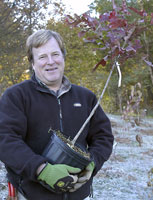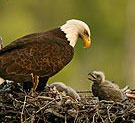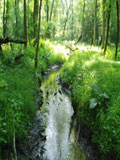|
|
|
 |
| Environmental Accomplishments |
 |
Environmental Accomplishments at BARC
- Businesses for the Bay Award
-

BARC has won a prestigious award in recognition of its leadership in nutrient management.
-
- Closing the Circle
 The White House Closing the Circle (CTC) Awards recognizes Federal employees and their facilities for efforts which resulted in significant contributions to or have made a significant impact on the environment. The White House Closing the Circle (CTC) Awards recognizes Federal employees and their facilities for efforts which resulted in significant contributions to or have made a significant impact on the environment.- Biobased Products
- BARC Environmental Management System
- BARC Biodiesel Demonstration
-
- BARC Hosts Tree Planting Event
 The Metropolitan Washington Council of Governments (COG) has partnered with the Beltsville Agricultural Research Center (BARC) to organize reforestation events in the Anacostia watershed. The Metropolitan Washington Council of Governments (COG) has partnered with the Beltsville Agricultural Research Center (BARC) to organize reforestation events in the Anacostia watershed.-
- Anacostia Watershed and Chesapeake Bay Restoration
- The Metropolitan Washington Council of Governments (COG) and the USDA, Agricultural Research Service's Beltsville Area signed an agreement to improve cooperation between the agencies on issues related to the restoration of the Anacostia Watershed and the Chesapeake Bay.
-
- River Herring Fish Transplantation Event
-
 On Saturday April 14th, 2007, the Metropolitan Washington Council of Governments in partnership
with the BARC, the National Oceanic and Atmospheric Administration, the Beaverdam Creek Watershed Watch
Group and friends, co-sponsored an Anacostia Watershed River herring fish transplantation event. The
purpose is to reintroduce anadromous fish species, such as alewife Herring, back into Beaverdam Creek subwatershed.
On Saturday April 14th, 2007, the Metropolitan Washington Council of Governments in partnership
with the BARC, the National Oceanic and Atmospheric Administration, the Beaverdam Creek Watershed Watch
Group and friends, co-sponsored an Anacostia Watershed River herring fish transplantation event. The
purpose is to reintroduce anadromous fish species, such as alewife Herring, back into Beaverdam Creek subwatershed.
-
- ARS’s Quest To Improve the Chesapeake Bay
 Several Agricultural Research Service (ARS) research groups are investigating ways to mitigate or prevent harm from farming practices. The scientists are working to improve phosphorus management; nitrogen efficiency; and manure composting, testing, and treatment to prevent movement of pollutants into the bay. Several Agricultural Research Service (ARS) research groups are investigating ways to mitigate or prevent harm from farming practices. The scientists are working to improve phosphorus management; nitrogen efficiency; and manure composting, testing, and treatment to prevent movement of pollutants into the bay.
-
-
 Forest Partnership
Forest Partnership
-
USDA Joins Partnership to Protect Rare Forest
-
WASHINGTON, Jan. 23, 2006--The Agricultural Research Service (ARS) signed an agreement today with the state of Maryland and other adjacent landowners to protect a 25,660-acre East Coast natural area in the nation's capital region. The signing marks the formation of the Baltimore-Washington Partners for Forest Stewardship to develop a comprehensive Forest Stewardship Plan.
-
- Chesapeake Research Pact
 On October 5th, 2005 at Chesapeake Bay Day, ARS/BARC signed a memorandum of understanding with the U.S. Environmental Protection Agency’s Chesapeake Bay Program (CBP), and the Mid-Atlantic Regional Water Quality Program of the Land Grant Universities. This Agreement will enhance research coordination to improve the health of the Chesapeake Bay, the largest estuary in the United States. On October 5th, 2005 at Chesapeake Bay Day, ARS/BARC signed a memorandum of understanding with the U.S. Environmental Protection Agency’s Chesapeake Bay Program (CBP), and the Mid-Atlantic Regional Water Quality Program of the Land Grant Universities. This Agreement will enhance research coordination to improve the health of the Chesapeake Bay, the largest estuary in the United States.-
- BARC Hosted Workshop on Bio-Based Products in Green Building
 The Use of Bio-based Products in Green Building Construction was held on June 10, 2005 at BARC. This workshop was convened by the Maryland Energy Administration (MEA), and it brought together individuals in the building trades with those from the bio-based products industry for a successful exchange of ideas and information. The Use of Bio-based Products in Green Building Construction was held on June 10, 2005 at BARC. This workshop was convened by the Maryland Energy Administration (MEA), and it brought together individuals in the building trades with those from the bio-based products industry for a successful exchange of ideas and information.-
- BARC Hosts Beaverdam Creek Watershed Education Workshop
 The Beaverdam Creek Watershed Education Workshop was held on October 1, 2005 at BARC. This workshop was convened by the Beaverdam Creek Watershed Watch Group and the Anacostia Watershed Citizen's Advisory Committee, in partnership with the Metropolitan Washington Council of Governments and the Summit Fund of Washington. It provided an opportunity to learn more about the watershed and how you can get involved in the protection and restoration of this unique area. The Beaverdam Creek Watershed Education Workshop was held on October 1, 2005 at BARC. This workshop was convened by the Beaverdam Creek Watershed Watch Group and the Anacostia Watershed Citizen's Advisory Committee, in partnership with the Metropolitan Washington Council of Governments and the Summit Fund of Washington. It provided an opportunity to learn more about the watershed and how you can get involved in the protection and restoration of this unique area.
According to Washington Metropolitan Council of Governments, Upper Beaverdam Creek, due to its generally healthy overall condition, was selected by the Maryland Department of the Environment as the reference Coastal Plain stream for the development of Maryland’s Anacostia Sediment Total Maximum Daily Load.-
- BARC Hosts Mid-Atlantic Composting and Compost Use Conference and Expo
 The Mid-Atlantic Composting and Compost Use Conference and Expo was held at BARC on September 21-23, 2005. The biennial event will include paper sessions and a trade show during the first two days and a tour of composting and compost use sites on the last day. This is a collaborative event planned by the Mid-Atlantic Composting Association (MACA) and extension and research faculty from mid-Atlantic region universities. Please visit www.midatlanticcompost.org The Mid-Atlantic Composting and Compost Use Conference and Expo was held at BARC on September 21-23, 2005. The biennial event will include paper sessions and a trade show during the first two days and a tour of composting and compost use sites on the last day. This is a collaborative event planned by the Mid-Atlantic Composting Association (MACA) and extension and research faculty from mid-Atlantic region universities. Please visit www.midatlanticcompost.org-
- Precision Agriculture Forum
- Dr. Ron Korcak, Associate Director of BARC, moderated a Precision Agriculture Forum which is sponsored by The Nutrient Management Program, a cooperative effort between Maryland Cooperative Extension and the Maryland Department of Agriculture, on September 21, 2005 at the Patuxent National Wildlife Center in Laurel, Maryland. The objective was to understand the opportunities for and the obstacles to expansion of the use of precision agriculture in Maryland and the region, to better understand the different technicalities that relate to geo-spatial information, and to evaluate and show the benefits of the technology for farmers, crop production, and the environment.
-
- BARC and the Chesapeake Bay
- On July 13, 2005 Scientists from our Crop Systems & Global Change Laboratory discussed the potential use of crop simulation models, developed at BARC, to better predict effects of agricultural best management practices on reducing nitrogen and phosphorous impacts on water quality at a Chesapeake Bay Program Nutrient Subcommittee meeting; the meeting was hosted by BARC.
-
- U.S. National Arboretum Community Partnership Work Day
- On Thursday morning, August 8, 2005, over 25 arboretum staff members joined residents of the Langston Craver Terrace community for a major cleanup project along the southern boundary of the U.S. National Arboretum. This effort was part of a joint project involving the Executive Office of the Mayor of the District of Columbia, local Advisory Neighborhood Commissions, the D.C. Department of Public Works, and local residents. This project will help upgrade and improve the neighborhood in the area of M Street in Northeast Washington, D.C. The work involves the removal of tons of numerous weed trees, shrubs, vines and illegally dumped trash and debris. The arboretum, the neighborhood, and the District of Columbia will continue to work together on this and future projects.
-
- Evaluating the Effectiveness of Riparian Buffers
- A series of systematic studies of a riparian grass buffer zone by BARC scientists Dr. Jim Starr, Dr. Ali Sadeghi, and Dr. Yakov Pachepsky has shown that a specially designed field chamber has proven itself to be a good tool when used together with a computer model to evaluate how effectively riparian buffers filter out pollutants before they can reach streams or other bodies of water. After success with a prototype chamber in the laboratory, the scientists installed a field version of the chamber through which they were able to monitor the rates of lateral water flow and the loss of nitrate due to its breakdown by soil microbes. Scientists used the two-dimensional computer model HYDRUS-2D to simulate water flow and transport of chemicals within the riparian zone soil. The experimental chamber is essential for the accurate use of the growing number of computer models being developed to assess the effectiveness of riparian buffers.
-
- You Have The Power
- Department of Energy's Federal Energy Management Program Energy Champions
-
|
|
|
|
|